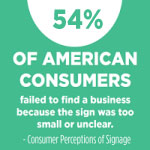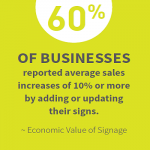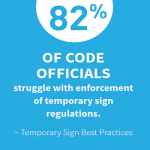The past several months have been unlike anything we have ever experienced (or probably could have even imagined outside the pages of a Stephen King novel). COVID-19’s virulent spread shuttered businesses, sequestered us in our homes and rapidly thrust the economy into double-digit-percentage unemployment. As dire as the economic consequences have been, the social and psychological costs have arguably been far greater. As of this writing, more than 2.5 million Americans are recorded as having been infected (given the limited accessibility of COVID-19 tests in many areas, the CDC recently estimated that approximately 20 million people have actually contracted the virus), and more than 125,000 people have died. Those who have not been medically impacted have still been forced to shelter in place, compelled to educate their children at home and are coping with few to no social outlets. The uncertainty has been suffocating and, at times, infuriating. We dutifully watched livestreamed performance events, bought masks and undertook herculean searches for toilet paper, hand sanitizer and soap.
Amid social-distancing guidelines, business closures and countless disruptions to our daily routines, we’re feeling isolated, fatigued and anxious. We want to have meaningful interactions with our neighbors and venture out into our communities, whether that means setting foot in a store, enjoying dinner at your favorite restaurant, or taking part in a favorite diversion. Our lexicon is now permeated with “physical distancing”, “contact tracing”, “community spread” and other virus jargon that triggers a drumbeat of anxiety. We’ve repeatedly weighed the risks of trips out into our communities against the benefits of fulfilling household needs or interacting with neighbors and relatives.
Thankfully, most states have continually recognized the sign industry as an essential enterprise, and shops are allowed, with distancing, sanitizing and other production parameters, to maintain operations. Healthcare entities, governmental offices and other essential organizations have continued operation, so fabrication and installation have, in many cases, moved forward.
However, countless industries have been crippled by the loss of customers and forced to furlough employees. More than 40 million Americans have filed unemployment claims since the pandemic’s mid-March onset. McKinsey & Co., a strategic-management consulting firm, has tracked consumer confidence amid COVID-19. Its report concluded that, as of early June, more than half of U.S. households had reduced spending over the prior two weeks, and an additional 27% anticipated lowering expenditures over the following two weeks. The survey also revealed that roughly one-third of respondents predicted an economic recovery within three months – a significant downturn from the 44% that predicated a rebound within 90 days back in mid-March.
More than 70% of survey participants stated that the COVID-19 aftermath will impact household finances for at least two months. According to the survey, 61% of Americans surveyed expressed that they were very or extremely concerned about the nation’s economy. Uncertainty of the pandemic’s length and concerns over their own health, the health of loved ones, and the wellness of the general public also registered high levels of concern among more than 50% of those polled. More than 90% of survey respondents expressed the belief that it will be at least two months until they could resume normal routines – approximately 40% stated it would take seven months or more before full resumption of pre-COVID-19 activities. Among 34 categories of products and services, only three sectors showed an increase since COVID-19’s onset: groceries, home entertainment and household supplies. The sectors with the largest decreases by percentage include domestic flights (-56%), hotel stays (-50%), international flights (-46%), adventures and tours (-43%), accessories (-43%) and jewelry (-40%).
The sign industry’s success is predicated upon the success of the businesses it serves – retail stores, restaurants and other entities that implement signage and numerous other forms of visual communications to identify their properties and create a definitive sense of place. We understand that the owners and employees at thousands of small businesses nationwide are more than the channel letters, vehicle wraps or digital displays they order. Our success is closely intertwined and incumbent upon their ability to thrive long-term. As such, we’ve reached out to business owners and executives representing companies of various sizes to discuss the measures they’re taking to support their employees and customers during challenging times.
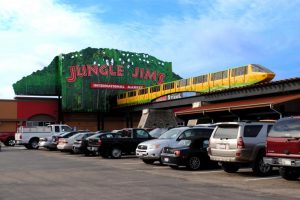
Jim Bonaminio founded Jungle Jim’s as a produce stand in 1971 and his unique grocery-store concept has evolved into two Cincinnati-area stores that each span more than 200,000 sq. ft. and offer expansive specialty and international-food sections.
Navigating Jungle Terrain
Operating a grocery store during the COVID-19 pandemic creates a double-edged sword. On the one hand, being a highly essential business, demand grew considerably as people were obliged, and are still encouraged, to cook at home. Conversely, the high demand required the need for an aggressive and cohesive plan to keep employees and customers safe. Jungle Jim’s, which was founded by “Jungle” Jim Bonaminio in 1971 and now operates two behemoth stores in the Cincinnati area. Jungle Jim’s maintains an expansive international-foods department, as well as cheese, beer, seafood and other specialty sections that rival any gourmet store. It has long appealed to the Queen City’s growing immigrant community and foodies alike with a whimsical motif that includes giant foam gorillas over the entrance, murals that reflect the merchandise in each individual section, and restrooms outfitted with a façade of porta-potties. As an independent operation, not tethered to a detached corporate office, Jungle Jim’s has proudly touted its uniqueness. When a crisis loomed, it was able to nimbly respond.
“We have a lot of customers who are natives of Asian countries,” Phill Adams, Jungle Jim’s director of development, said. “They were highly aware of the looming crisis there very early on, and we caught on to its magnitude as well. By mid-January, we had a pandemic-response team in place. We established temperature checks, physical-distancing signage and protocols, and other safety measures at an early stage.”
Jungle Jim’s quickly accumulated large quantities of staples, such as rice, and was able to leverage its immense warehousing capacity (the original store in Fairfield, north of Cincinnati, spans 215,000 sq. ft., and its younger sibling, in Eastgate, measures 230,000 sq. ft.) to buy large quantities ahead of the curve to get ready for the hoarding associated with the pandemic. The company maintains a vigorous social-media presence, and aggressive use of these platforms helped quickly alert customers when sought-after products were available, and Jungle Jim’s shoppers proactively broadcast this information.

Lighthearted humor is central to the Jungle Jim’s brand, and has played a key role in developing its loyal following.
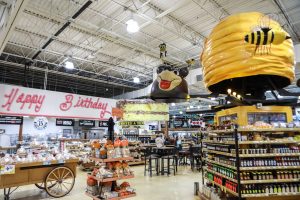
Much of Jungle Jim’s kitschy décor has been scavenged from defunct stores, theme parks and various seemingly unlikely sources.
“We did run out of some supplies like toilet paper, but we were able to replenish relatively quickly,” Adams said. “We might not have had Kraft macaroni and cheese, but we had another brand in stock, and our customers found they enjoyed trying something different. We had been a lot of people’s special-occasion store, for when they were hosting a party or needed something unusual, but we’ve become some customers’ go-to store during the pandemic.”
Jungle Jim’s has built its brand on fun, lighthearted engagement with its customers, and has strived to maintain it amid a challenging climate. Adams quipped, “’We’re in this together’ and ’Don’t monkey around; wear a mask’ are about as serious as we get in our messaging to customers. Mask-wearing lagged for a few weeks, but, as cases have increased, we’ve seen mask usage increase as well.”
Whereas many grocers are emphasizing e-commerce, Jungle Jim’s has forged its own path by emphasizing shopping as an on-premises experience, and many of its patrons use it as an inexpensive form of family entertainment while shopping. It’s been a successful recipe. Plans are in place for an additional 16,000 sq. ft. for the Fairfield location, and 45,000 more sq. ft. of space in Eastgate. The maxim might dictate, “You can’t be all things to all people.” However, by thoughtfully embracing both “alls” in that statement, Jungle Jim’s, has proven that a grocery store can, in fact, do so successfully.
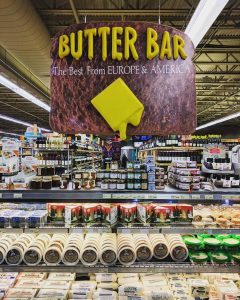
Every Jungle Jim’s department resembles a premium specialty shop where foodies can secure gourmet grub, beer and wine.
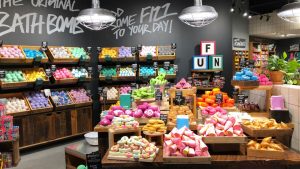
Lush, a cosmetics and beauty-product chain with 264 North American stores, creates colorful curb appeal with its array of soaps, bath bombs, moisturizers, and the like.
Lush Cosmetics: A Fresh Take
There’s no shortage of purveyors of beauty products. To thrive in a crowded market, Lush Cosmetics has sought to redefine the market segment with an emphasis on natural products made fresh to order – and with a commitment to environmental sustainability and a total animal-testing ban throughout its supply chain. Mark Constantine and Liz Weir founded Lush in Poole, England in 1995, and Mark Wolverton and Karen Delaney-Wolverton opened the company’s first North American store in Vancouver one year later. Today, the company maintains 264 stores throughout the U.S. and Canada, and the company’s culture of warm engagement remains intact.
Brandi Halls, Lush Cosmetics’ North America Brand Director, noted that the company has, in recent years, gone against the grain of migrating to emphasizing digital commerce over bricks-and-mortar stores: “Lush is a full sensory experience. Our products are created to be touched [and] smelled, which is only possible in store, and that is what has made our physical retail businesses so successful. Customers love coming into our stores and interacting with our staff, which has been the root of our success.”
The realities of COVID-19 and the resulting shutdowns of retail entities has paused the company’s consumer experience, which has been built upon in-store consultations and product demonstrations. However, the company has pivoted effectively by instituting 30-minute virtual consultations, for which customers can register on the company’s website.
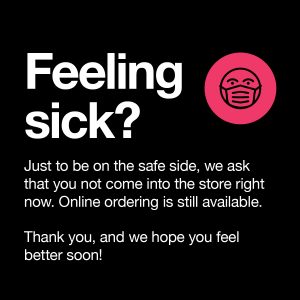
An example of one of Lush’s signs asking ill customers to stay home.

As COVID-19 safety best practices enables stores to reopen with limited capacity, workers are coached how to properly perform “contactless” in-store pick-ups.
As of mid-June, the company had reopened 99 of its 264 stores, with the remainder slated to resume onsite operations on a staggered schedule, influenced by regional and state requirements, to open by the end of July. Halls said, “Lush is taking a people-first, phased approach to its reopening strategy. Beginning with a phased rollout of contactless pick-up, it’s now shifting toward buying online with in-store pick-up as shops open at reduced capacity.” She noted that each phase is based on current local-government and CDC recommendations, establishment of and compliance with cleanliness standards, in-shop training, and the comfort level with reopening on each store’s staff.
Specific safety measures include reducing capacity based on each store’s square footage including installing 6-ft.-distancing markers and signage, providing access to clean sinks and soaps for customer handwashing upon entry, allowing no-contact payment, requiring that cash wraps sanitized after each customer transaction, and requesting that staff wear masks and wash hands before each customer interaction.
“COVID-19 gave us the chance to really pause, take a step back and look at what we felt was the most important thing to be talking about online,” Hills said. “We continued to use our social-media presence to connect with our community and produce content that would resonate with them and provide a solution to any challenges or concerns people were facing. We adapted to what is happening around us by pausing or cancelling many of our previously planned campaigns and promotional activity to remain current and flexible in a time of fast and constant change. We’ve chosen to talk about what matters to our customers, addressing their concerns and we’ve pivoted from our usual day to day.”
Under the “Stories” header on its homepage, the important conversations Lush is having with its customers include “Being Black in COVID-19”, authored by Miami based, African American artist, Phillip Agnew. It’s an unflinching look at the disproportionate economic and social challenges that minorities face, such as living in high-density housing and being largely employed in front-line “essential” jobs, putting them at the highest risk of contracting COVID-19. Under the “Charity Pot” homepage header, Lush offers a body lotion made from fair-trade products for which all proceeds are donated to organizations that support environmentalism and social justice. This header also includes the engaging stories of Charity Pot’s partner organizations, such as the Ripple Effect, which creates sustainable-agriculture opportunities for an indigenous tribe in Guatemala, and The Mesh Exchange, which helps redistribute surplus food to needy families.

Floor decals are an important way to remind customers to maintain 6-ft. social distancing. Lush made theirs fun by playing off of their numerous bath-related products.
Flying Biscuit: Providing Comfort Safely
In 1993, the Flying Biscuit Café opened in Candler Park, an historic neighborhood on Atlanta’s east side. Serving a Southern-infused menu of comfort food for breakfast, brunch and lunch, the restaurant grew methodically into a chain with 23 locations across six states. Joseph Hsiao is the CEO of H Restaurant Group, which includes Flying Biscuit’s flagship Candler Park and Midtown locations, as well as the West Cobb and South Cobb Diners, FLIP burger boutique and Pisano’s Pizzeria. Before COVID-19 became an existential threat to his industry, Hsiao said the restaurant business’s most profound challenge was the frenzied competition from the creation of new dining concepts. The increased demand from younger patrons for takeout and third-party delivery required pivoting to accommodate. Unfortunately, the widespread layoffs and closures have thinned the herd of available restaurants and pandemic realities have shifted to delivery-centric dining. “Partnering with third-party delivery has been part of our business model for a long time, so we were well prepared for the migration to a delivery-based business,” he said.
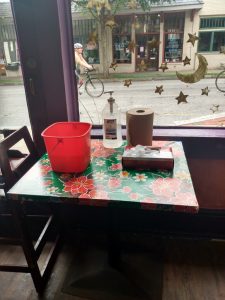
Founded in Atlanta in the early ‘90s, Flying Biscuit has become a brunch staple throughout Georgia that has expanded into several other Southern states.
Health-department inspections are an ongoing reality for restaurants (Georgia requires health-department-inspection grades be posted prominently near an establishment’s entrance) and COVID-19-related sanitizing stipulations have amplified cleanliness requirements. He said, “It required training to get our team members acclimated to cleaning high-touch areas more frequently and thoroughly – tables, counters, restrooms, door handles, point-of-sale terminals, coolers, etc. — and to become accustomed to wearing a mask for a shift of up to six hours. We’ve always had a third-party contractor handle each store’s deep cleaning, but we’ve ramped up the frequency of their visits and the extensiveness of their work.”
Georgia Governor Brian Kemp was among the first U.S. governors to open his state’s businesses in late April, with restaurants being given the green light to bring in customers, provided they limit capacity to 50% of fire-code limits, install protective equipment and have sufficient sanitizing materials available. Hsiao is a board member for the Georgia Restaurant Association and witnessed a variety of sentiments among his industry’s leaders. Some restaurants enthusiastically opened their doors on the first day it was permitted, such as the Waffle House chain, while others, like Atlanta’s five-location, La Fonda Latina, are keeping dining rooms closed. Hsiao decided to charter a middle course.
“We wanted to make sure our team members were comfortable with the idea of reopening, and the procedures required,” he said. “We opened about two weeks after the state of Georgia permitted it. Supplies of PPE and sanitizing equipment were scarce, but we managed to obtain enough of both to resume in-store operations. We handled every location a bit differently; for smaller footprints, we marked off-limits areas.”
In addition to following mandates of employees wearing masks and gloves, Hsiao’s team took the added safety measure of printing “contactless” menus that include a QR code which enables smartphone users to download the restaurant’s offerings without handling menus. Hsiao said he’s likely to retain these safety measures even beyond the development of proven COVID-19 vaccines or treatments.
To help protect the livelihoods of the 255 workers Hsiao employs directly, he obtained CARES Act SBA loans of $125,000 to $150,000 for each of his six restaurants. He also took out a second mortgage on his home to ensure the bills stayed paid. He said, “My employees expressed gratitude for taking the steps to make sure our doors stayed open. I did my best to make sure our team stayed positive, and to have faith that we would stay together, and that God would get us through this.”
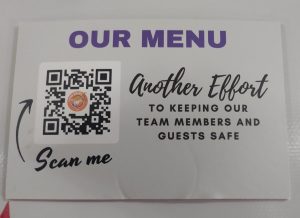
To diminish the risk of COVID-19 infection, Flying Biscuit has instituted no-touch menus, with a QR code that enables a smartphone download to view its fare.
Flying Biscuit has earned considerable brand recognition – their accolades include Entrepreneur’s Top 200 Food Franchises and FSR’s Top 50 Emerging Restaurant Chains. This influence has presumably helped its revenue return quickly to pre-COVID-19 levels, though Hsiao said many of his traditionally dine-in customers have migrated to takeout orders, and are likely to keep doing so for the foreseeable future.
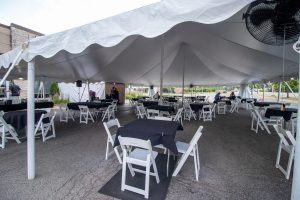
At Cooper’s Hawk, a 43-location restaurant chain primarily anchored in the Midwest, the vino in the stemware co-stars with what’s on the plate.
Cooper’s Hawk Soars
At most restaurants, wine is a secondary accompaniment to a meal. In 2005, Tim McEnery differentiated Cooper’s Hawk by creating a wine-centric dining experience and Napa-style tasting room that offers its own line of award-winning house-label wines. The concept was named after both the hawk, an indigenous bird to North America, and a “cooper”, or a person who crafts wine barrels. Cooper’s Hawk offers menu items paired with bin numbers to help demystify food and wine pairings. Today they have grown to include 43 locations across 10 states, with more than 7 million guests annually and nearly 500,000 members of its wine club.
Before COVID-19’s onset, McEnery viewed training and developing his employees as the company’s biggest challenge. He said, “We work in an extremely competitive industry, where there is a lot of turnover. Finding good people is a challenging task. One silver lining of the current high unemployment rate is a larger talent pool when we are fully open and looking to expand our team.’
Cooper’s Hawk has adapted to offer carryout and delivery in all but one of its locations and more than 90% of its restaurants have reopened their dining rooms. McEnery said, “We reopened because of the demand from customers and employees while satisfying the priorities of worker and guest safety, monitoring how restaurants are operating, and weighing how quickly we could bring our team back to work. Wine club members were very vocal about missing their favorite wines and food items and we heard them.”
While its locations were shuttered, Cooper’s Hawk took an extra step of caring for its furloughed employees by preparing daily lunch and dinners for them and their families.
The company kept its legions of Wine Club enthusiasts satisfied by maintaining its monthly wine club offerings on a takeout basis and reinforced its newfound emphasis on takeout business by introducing sparkling sangria and other sparkling products.
“We’re going to continue to look for ways to diversify our business, embracing the ‘to-go’ model, and give our customers more of the good life!”, McEnery proclaimed.
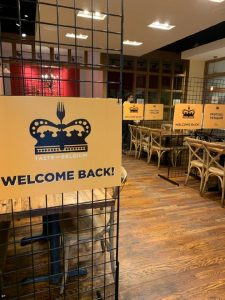
More “welcome back” signs inviting Taste of Belgium patrons back.
Taste of Belgium: Keeping it Light
In 2007, native Belgian Jean-Francois Flechet brought a 120-lb., cast-iron waffle maker from his home country to a produce store at Cincinnati’s Findlay Market. Findlay Market is Ohio’s oldest, continually operated, public market that houses more than 50 merchants. Soon, demand was so high for his fluffy confections that he opened his own store at the market. In 2011, Flechet unveiled his first bistro location at Over the Rhine, a historic downtown Cincinnati neighborhood that has been reinvigorated over the last decade. In addition to its signature sweet and savory waffles, Taste of Belgium expanded its fare to include crepes, sandwiches, salads, an expansive coffee bar and desserts (insider tip: the macaroons are excellent). Two more locations opened in trendy Cincinnati neighborhoods, Clifton and Hyde Park, and Taste of Belgium plans to open its first Kentucky location later this summer. Josh Baker, taste of Belgium’s marketing director and a foodservice and hospitality veteran with nearly two decades of experience, said the challenges facing his industry haven’t changed, but have simply intensified.
“It’s always crucial for a restaurant concept to stay top of mind and relevant,” he said. “A restaurant has a shine to it when it’s new and people are excited to try something different. But, eventually, you’re no longer the new place, so you have to do things to keep your brand innovative and interesting. This is an even greater challenge than ever now. You’re not just competing against other restaurants; you’re countering people’s anxiety about the virus to even leave the house.”
Another challenge restaurants face amid the pandemic is hiring and retaining staff. Even amid high unemployment, Baker noted how there is a reluctance from people to fill such positions because the pandemic induces anxiety about working in a job where social distancing is difficult. Before the pandemic, he said Taste of Belgium employed a staff of 250; he’s uncertain of the specific number, but acknowledged that there’s been attrition.
Like most restaurants, Taste of Belgium rapidly adapted to shutdown requirements. Prior to the COVID-19-induced shutdown, Baker said less than 10% of Taste of Belgium’s business came from carryout orders, and none from delivery. This changed overnight as Ohio loosened its regulations to permit takeout and delivery sales of alcohol and helped Taste of Belgium buoy their sales amid challenging times.
Four of its locations are currently open. The Clifton store, whose delay is related to staffing issues, is slated to resume in-store dining by the end of July. The Taste of Belgium team has strived to maintain its sense of humor during a crisis. The signage installed to reinforce distance and public-health messaging, also includes trivia queries offered to guests to inject some chuckles with Monty Python, Harry Potter and The Big Lebowski references. Baker said the jokes were reflecting of how the brand doesn’t take itself too seriously.
As the COVID-19 onset hit in March, Taste of Belgium had to pause its expansion plans. However, its team is persevering as much as the current landscape allows. He said, “We have to stay aggressive while staying smart. Throughout history, people who have given in to fear and not reached for more during difficult times have ultimately failed.”
The current climate has necessitated moving away from happy-hour specials and shareable-portion appetizers, and towards emphasizing packaged to-go dishes. Baker said, “Improving our brand will include revamping our website to include more to-go offerings. Right now, it’s just waffles and coffee, but we’re changing that to reflect the variety our customers want.”
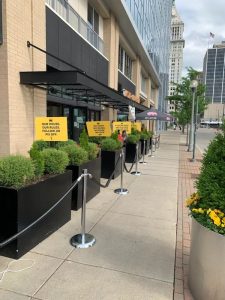
Jean-Francois Flechet began Taste of Belgium as a waffle-making stand within a produce store. He eventually opened a freestanding restaurant and has gradually expanded to five locations throughout the Cincinnati area.
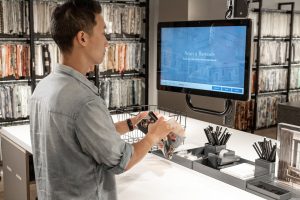
OpenEye Global is a New Jersey-based company that integrates digital-display visual communications for institutional, retail and experiential-entertainment clients, has helped its clients convey information with less physical contact and helped stores comply with COVID-19 regulations.
Digital Signage’s Key Role
Digital-display technology plays a vital role in helping disseminate information to the public. Efficiently and concisely, this technology conveys relevant physical-distancing and public-health information. Operating with cloud-based, content-management systems, displays present information in real time and can be transmitted from virtually anywhere.
Bryan Meszaros is the president of OpenEye Global, a New Jersey-based company that installs digital-display visual communications for financial, institutional and experiential-entertainment clients. Bryan cited several reasons for their technology’s ascendance.
“As cost has decreased and the clarity and performance of screens has increased, adoption has become much more widespread,” he said. “Also, as onboard media players have become more robust, it’s been easier to integrate all-in-one solutions. Whether it’s menu boards at a [quick-serve restaurant], or an interactive display or kiosk at a retail store or transportation hub, the array of solutions at attractive price points makes them a no-brainer.”
Meszaros formerly served as president of the Society for Experiential Graphic Design (SEGD), an educational and advocacy organization that serves environmental designers, architects, sign fabricators and other visual-communications providers. His several years of close involvement with SEGD and the design community have helped reduce the learning curve.
“A lot of designers are beginning to understand that clients have specs they have to meet, particularly in transportation hubs,” he said. “Also, the displays’ improving performance have helped them be perceived as not just transactional, but as aesthetically pleasing and an asset to the total environment. It doesn’t have to just be a screen on the wall anymore; it’s simpler now to present them anywhere within an environment. They’re able to improve brand strategies and creative experiences.”
Although COVID-19’s spread has necessitated broader adoption of digital screens, Meszaros said it’s more difficult to implement at this stage for those inexperienced with the technology. He noted that, if a company hasn’t previously incorporated digital displays or previously allocated the budget, forced late-stage adoption could be challenging because of the expense of learning the technology’s nuances and starting from scratch with hardware and content-management platforms.
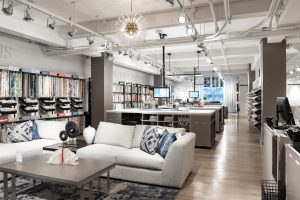
OpenEye Global outfitted Kravet, an upscale supplier of furniture, décor and wall coverings, with interactive digital displays for its New York design studio.
Santander Bank, an East Coast institution with more than 500 branches in nine states, is a longtime OpenEye Global client. Developing digital-communications solutions required some customization. Urban and suburban locations occupy differing footprints, with some locations having exterior-facing displays and others with screens located outside the facility or only visible from the interior. He said, “Customer access differed from location to location across several states, with some fully accessible and others drive-through only. Either way, there were still opportunities to create consistent messaging that provided public-health information, financial news and other relevant or engaging information.”
Kravet, an upscale purveyor of furniture, décor and wallcoverings, is another OpenEye Global client that is seeking to take its digital-display communication to cutting-edge levels, and is investigating facial- and voice-recognition software. This is particularly significant following COVID-19 adaptations, as digital technology enables front-line customer engagement while minimizing person-to-person interactions. OpenEye Global’s experiential clients, such as Madame Tussaud’s Wax Museums and Sea Life Aquariums, have remained closed.
Meszaros said that one key obstacle to realizing digital’s potential is engineering experiences that facilitate more efficient time spent in front of screens. He said, “I think there is more empathy for consumers, and there’s a desire to enhance the digital touchpoint. This is even more vital when facilitating quick usage to minimize exposure to an airborne virus. Design impacts how we use technology, and we want to create good experiences.”


